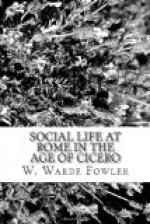CHAPTER IX
THE DAILY LIFE OF THE WELL-TO-DO
Before giving some account of the way in which a Roman of consideration spent his day in the time of Cicero, it seems necessary to explain briefly how he reckoned the divisions of the day.
The old Latin farmer knew nothing of hours or clocks. He simply went about his daily work with the sun and the light as guides, rising at or before sunrise, working till noon, and, after a meal and a rest, resuming his work till sunset. This simple method of reckoning would suffice in a sunny climate, even when life and business became more complicated; and it is a fact that the division of the day into hours was not known at Rome until the introduction of the sun-dial in 263 B.C.[407] We may well find it hard to understand how such business as the meeting of the senate, of the comitia, or the exercitus, could have been fixed to particular times under such circumstances; perhaps the best way of explaining it is by noting that the Romans were very early in their habits, and that sunrise is a point of time about which there can be no mistake[408]. But in any case the date of the introduction of the sun-dial, which almost exactly corresponds with the beginning of the Punic wars and the vast increase of civil business arising out of them, may suggest at once the primitive condition of the old Roman mind and habit, and the way in which the Romans had to learn from other peoples how to save and arrange the time that was beginning to be so precious.
This first sun-dial came from Catina in Sicily, and was therefore quite unsuited to indicate the hours at Rome. Nevertheless Rome contrived to do with it until nearly a century had elapsed; at last, in 159 B.C., a dial calculated on the latitude of Rome was placed by the side of it by the censor Q. Marcius Philippus. These two dials were fixed on pillars behind the Rostra in the Forum, the most convenient place for regulating public business, and there they remained even in the time of Cicero[409]. But in the censorship next following that of Philippus the first water-clock was introduced; this indicated the hours both of day and night, and enabled every one to mark the exact time even on cloudy days[410].
Thus from the time of the Punic wars the city population reckoned time by hours, i.e. twelve divisions of the day; but as they continued to reckon the day from sunrise to sunset on the principle of the old agricultural practice, these twelve hours varied in length at different times of the year. In mid-winter the hours were only about forty-four minutes in length, while at mid-summer they were about seventy-five, and they corresponded with ours only at the two equinoxes.[411] This, of course, made the construction of accurate dials and water-clocks a matter of considerable difficulty. It is not necessary here to explain how the difficulties were overcome; the reader may be referred to the article “Horologium” in the Dictionary of Antiquities, and especially to the cuts there given of the dial found at Tusculum in 1761.[412]




